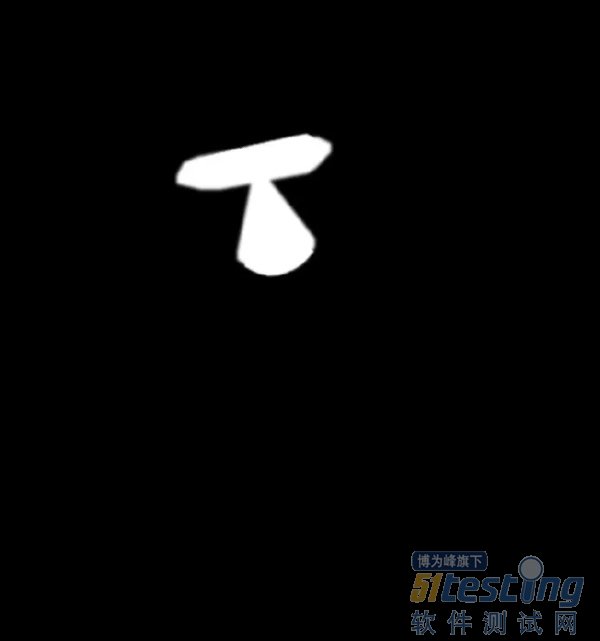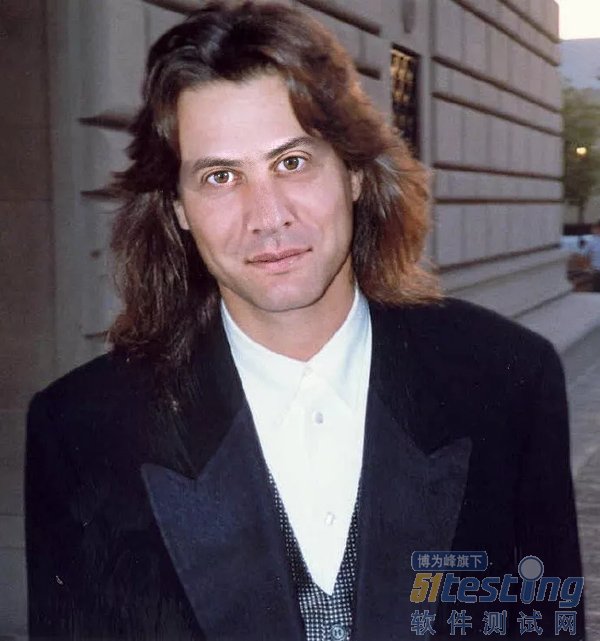4.把第二张图像的特征混合在第一张图像中
用一个遮罩来选择图像2和图像1的哪些部分应该是最终显示的图像:
值为1(显示为白色)的地方为图像2应该显示出的区域,值为0(显示为黑色)的地方为图像1应该显示出的区域。值在0和1之间为图像1和图像2的混合区域。
这是生成上图的代码:
LEFT_EYE_POINTS = list(range(42, 48)) RIGHT_EYE_POINTS = list(range(36, 42)) LEFT_BROW_POINTS = list(range(22, 27)) RIGHT_BROW_POINTS = list(range(17, 22)) NOSE_POINTS = list(range(27, 35)) MOUTH_POINTS = list(range(48, 61)) OVERLAY_POINTS = [ LEFT_EYE_POINTS + RIGHT_EYE_POINTS + LEFT_BROW_POINTS + RIGHT_BROW_POINTS, NOSE_POINTS + MOUTH_POINTS, ] FEATHER_AMOUNT = 11 def draw_convex_hull(im, points, color): points = cv2.convexHull(points) cv2.fillConvexPoly(im, points, color=color) def get_face_mask(im, landmarks): im = numpy.zeros(im.shape[:2], dtype=numpy.float64) for group in OVERLAY_POINTS: draw_convex_hull(im, landmarks[group], color=1) im = numpy.array([im, im, im]).transpose((1, 2, 0)) im = (cv2.GaussianBlur(im, (FEATHER_AMOUNT, FEATHER_AMOUNT), 0) > 0) * 1.0 im = cv2.GaussianBlur(im, (FEATHER_AMOUNT, FEATHER_AMOUNT), 0) return im mask = get_face_mask(im2, landmarks2) warped_mask = warp_im(mask, M, im1.shape) combined_mask = numpy.max([get_face_mask(im1, landmarks1), warped_mask], axis=0) |
我们把上述过程分解:
get_face_mask()的定义是为一张图像和一个标记矩阵生成一个遮罩,它画出了两个白色的凸多边形:一个是眼睛周围的区域,一个是鼻子和嘴部周围的区域。之后它由11个像素向遮罩的边缘外部羽化扩展,可以帮助隐藏任何不连续的区域。
这样一个遮罩同时为这两个图像生成,使用与步骤2中相同的转换,可以使图像2的遮罩转化为图像1的坐标空间。
之后,通过一个element-wise最大值,这两个遮罩结合成一个。结合这两个遮罩是为了确保图像1被掩盖,而显现出图像2的特性。
最后,使用遮罩得到最终的图像:
output_im = im1 * (1.0 - combined_mask) + warped_corrected_im2 * combined_mask
完整代码(link):
import cv2 import dlib import numpy import sys PREDICTOR_PATH = "/home/matt/dlib-18.16/shape_predictor_68_face_landmarks.dat" SCALE_FACTOR = 1 FEATHER_AMOUNT = 11 FACE_POINTS = list(range(17, 68)) MOUTH_POINTS = list(range(48, 61)) RIGHT_BROW_POINTS = list(range(17, 22)) LEFT_BROW_POINTS = list(range(22, 27)) RIGHT_EYE_POINTS = list(range(36, 42)) LEFT_EYE_POINTS = list(range(42, 48)) NOSE_POINTS = list(range(27, 35)) JAW_POINTS = list(range(0, 17)) # Points used to line up the images. ALIGN_POINTS = (LEFT_BROW_POINTS + RIGHT_EYE_POINTS + LEFT_EYE_POINTS + RIGHT_BROW_POINTS + NOSE_POINTS + MOUTH_POINTS) # Points from the second image to overlay on the first. The convex hull of each # element will be overlaid. OVERLAY_POINTS = [ LEFT_EYE_POINTS + RIGHT_EYE_POINTS + LEFT_BROW_POINTS + RIGHT_BROW_POINTS, NOSE_POINTS + MOUTH_POINTS, ] # Amount of blur to use during colour correction, as a fraction of the # pupillary distance. COLOUR_CORRECT_BLUR_FRAC = 0.6 detector = dlib.get_frontal_face_detector() predictor = dlib.shape_predictor(PREDICTOR_PATH) class TooManyFaces(Exception): pass class NoFaces(Exception): pass def get_landmarks(im): rects = detector(im, 1) if len(rects) > 1: raise TooManyFaces if len(rects) == 0: raise NoFaces return numpy.matrix([[p.x, p.y] for p in predictor(im, rects[0]).parts()]) def annotate_landmarks(im, landmarks): im = im.copy() for idx, point in enumerate(landmarks): pos = (point[0, 0], point[0, 1]) cv2.putText(im, str(idx), pos, fontFace=cv2.FONT_HERSHEY_SCRIPT_SIMPLEX, fontScale=0.4, color=(0, 0, 255)) cv2.circle(im, pos, 3, color=(0, 255, 255)) return im def draw_convex_hull(im, points, color): points = cv2.convexHull(points) cv2.fillConvexPoly(im, points, color=color) def get_face_mask(im, landmarks): im = numpy.zeros(im.shape[:2], dtype=numpy.float64) for group in OVERLAY_POINTS: draw_convex_hull(im, landmarks[group], color=1) im = numpy.array([im, im, im]).transpose((1, 2, 0)) im = (cv2.GaussianBlur(im, (FEATHER_AMOUNT, FEATHER_AMOUNT), 0) > 0) * 1.0 im = cv2.GaussianBlur(im, (FEATHER_AMOUNT, FEATHER_AMOUNT), 0) return im def transformation_from_points(points1, points2): """ Return an affine transformation [s * R | T] such that: sum ||s*R*p1,i + T - p2,i||^2 is minimized. """ # Solve the procrustes problem by subtracting centroids, scaling by the # standard deviation, and then using the SVD to calculate the rotation. See # the following for more details: # https://en.wikipedia.org/wiki/Orthogonal_Procrustes_problem points1 = points1.astype(numpy.float64) points2 = points2.astype(numpy.float64) c1 = numpy.mean(points1, axis=0) c2 = numpy.mean(points2, axis=0) points1 -= c1 points2 -= c2 s1 = numpy.std(points1) s2 = numpy.std(points2) points1 /= s1 points2 /= s2 U, S, Vt = numpy.linalg.svd(points1.T * points2) # The R we seek is in fact the transpose of the one given by U * Vt. This # is because the above formulation assumes the matrix goes on the right # (with row vectors) where as our solution requires the matrix to be on the # left (with column vectors). R = (U * Vt).T return numpy.vstack([numpy.hstack(((s2 / s1) * R, c2.T - (s2 / s1) * R * c1.T)), numpy.matrix([0., 0., 1.])]) def read_im_and_landmarks(fname): im = cv2.imread(fname, cv2.IMREAD_COLOR) im = cv2.resize(im, (im.shape[1] * SCALE_FACTOR, im.shape[0] * SCALE_FACTOR)) s = get_landmarks(im) return im, s def warp_im(im, M, dshape): output_im = numpy.zeros(dshape, dtype=im.dtype) cv2.warpAffine(im, M[:2], (dshape[1], dshape[0]), dst=output_im, borderMode=cv2.BORDER_TRANSPARENT, flags=cv2.WARP_INVERSE_MAP) return output_im def correct_colours(im1, im2, landmarks1): blur_amount = COLOUR_CORRECT_BLUR_FRAC * numpy.linalg.norm( numpy.mean(landmarks1[LEFT_EYE_POINTS], axis=0) - numpy.mean(landmarks1[RIGHT_EYE_POINTS], axis=0)) blur_amount = int(blur_amount) if blur_amount % 2 == 0: blur_amount += 1 im1_blur = cv2.GaussianBlur(im1, (blur_amount, blur_amount), 0) im2_blur = cv2.GaussianBlur(im2, (blur_amount, blur_amount), 0) # Avoid divide-by-zero errors. im2_blur += 128 * (im2_blur <= 1.0) return (im2.astype(numpy.float64) * im1_blur.astype(numpy.float64) / im2_blur.astype(numpy.float64)) im1, landmarks1 = read_im_and_landmarks(sys.argv[1]) im2, landmarks2 = read_im_and_landmarks(sys.argv[2]) M = transformation_from_points(landmarks1[ALIGN_POINTS], landmarks2[ALIGN_POINTS]) mask = get_face_mask(im2, landmarks2) warped_mask = warp_im(mask, M, im1.shape) combined_mask = numpy.max([get_face_mask(im1, landmarks1), warped_mask], axis=0) warped_im2 = warp_im(im2, M, im1.shape) warped_corrected_im2 = correct_colours(im1, warped_im2, landmarks1) output_im = im1 * (1.0 - combined_mask) + warped_corrected_im2 * combined_mask cv2.imwrite('output.jpg', output_im) |

















